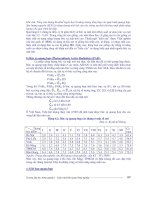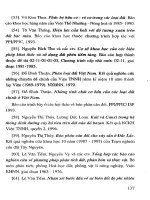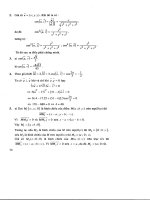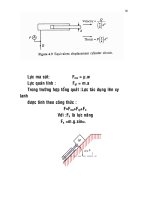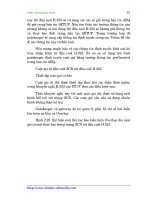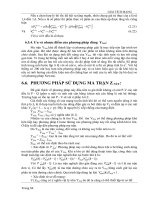Code Examplets phần 6 pps
Bạn đang xem bản rút gọn của tài liệu. Xem và tải ngay bản đầy đủ của tài liệu tại đây (5.93 MB, 26 trang )
drawGraphics(g, pf);
return Printable.PAGE_EXISTS;
}
}
}
Examplets
TM
provided by permission of the publisher, Addision-Wesley, and
Author Patrick Chan.
Order this book from Amazon
[ This page was updated: 19-Jul-2000 ]
Products & APIs | Developer Connection | Docs & Training | Online Support
Community Discussion | Industry News | Solutions Marketplace | Case Studies
Glossary - Applets - Tutorial - Employment - Business & Licensing - Java Store - Java in the Real World
FAQ | Feedback | Map | A-Z Index
For more information on Java technology
and other software from Sun Microsystems, call:
(800) 786-7638
Outside the U.S. and Canada, dial your country's
AT&T Direct Access Number first.
Copyright © 1995-2000 Sun Microsystems, Inc.
All Rights Reserved. Terms of Use. Privacy Policy.
Code Samples from the Java Developers Almanac 2000
(2 of 2) [8/1/2000 7:49:38 AM]
java.awt.print
Code Samples Index
These code examples and other materials are subject to Sun Microsystems,
Inc. Legal Terms
Displaying the Page Format Dialog
The page format dialog allows the user to change the default page
format values such as the orientation and paper size.
PrinterJob pjob = PrinterJob.getPrinterJob();
// Get and change default page format settings if
// necessary.
PageFormat pf = pjob.defaultPage();
pf.setOrientation(PageFormat.LANDSCAPE);
// Show page format dialog with page format settings.
pf = pjob.pageDialog(pf);
Examplets
TM
provided by permission of the publisher, Addision-Wesley, and
Author Patrick Chan.
Order this book from Amazon
[ This page was updated: 19-Jul-2000 ]
Products & APIs | Developer Connection | Docs & Training | Online Support
Community Discussion | Industry News | Solutions Marketplace | Case Studies
Glossary - Applets - Tutorial - Employment - Business & Licensing - Java Store - Java in the Real World
FAQ | Feedback | Map | A-Z Index
For more information on Java technology
and other software from Sun Microsystems, call:
(800) 786-7638
Outside the U.S. and Canada, dial your country's
AT&T Direct Access Number first.
Copyright © 1995-2000 Sun Microsystems, Inc.
All Rights Reserved. Terms of Use. Privacy Policy.
Code Samples from the Java Developers Almanac 2000
[8/1/2000 7:49:39 AM]
java.awt.print
Code Samples Index
These code examples and other materials are subject to Sun Microsystems,
Inc. Legal Terms
Displaying the Print Dialog
The print dialog allows the user to change the default printer
settings such as the default printer, number of copies, range of
pages, etc.
PrinterJob pjob = PrinterJob.getPrinterJob();
PageFormat pf = pjob.defaultPage();
pjob.setPrintable(new PrintableClass(), pf);
try {
if (pjob.printDialog()) {
pjob.print();
}
} catch (PrinterException e) {
}
Examplets
TM
provided by permission of the publisher, Addision-Wesley, and
Author Patrick Chan.
Order this book from Amazon
[ This page was updated: 19-Jul-2000 ]
Products & APIs | Developer Connection | Docs & Training | Online Support
Community Discussion | Industry News | Solutions Marketplace | Case Studies
Glossary - Applets - Tutorial - Employment - Business & Licensing - Java Store - Java in the Real World
FAQ | Feedback | Map | A-Z Index
For more information on Java technology
and other software from Sun Microsystems, call:
(800) 786-7638
Outside the U.S. and Canada, dial your country's
AT&T Direct Access Number first.
Copyright © 1995-2000 Sun Microsystems, Inc.
All Rights Reserved. Terms of Use. Privacy Policy.
Code Samples from the Java Developers Almanac 2000
[8/1/2000 7:49:40 AM]
java.lang.ref
Code Samples Index
These code examples and other materials are subject to Sun Microsystems, Inc.
Legal Terms
Holding onto an Object Until Memory Becomes Low
A soft reference holds onto its referent until memory becomes low.
// Create up the soft reference.
SoftReference sr = new SoftReference(object);
// Use the soft reference.
Object o = sr.get();
if (o != null) {
process(o);
} else {
// The object is being collected or has been reclaimed.
}
Examplets
TM
provided by permission of the publisher, Addision-Wesley, and
Author Patrick Chan.
Order this book from Amazon
[ This page was updated: 19-Jul-2000 ]
Products & APIs | Developer Connection | Docs & Training | Online Support
Community Discussion | Industry News | Solutions Marketplace | Case Studies
Glossary - Applets - Tutorial - Employment - Business & Licensing - Java Store - Java in the Real World
FAQ | Feedback | Map | A-Z Index
For more information on Java technology
and other software from Sun Microsystems, call:
(800) 786-7638
Outside the U.S. and Canada, dial your country's
AT&T Direct Access Number first.
Copyright © 1995-2000 Sun Microsystems, Inc.
All Rights Reserved. Terms of Use. Privacy Policy.
Code Samples from the Java Developers Almanac 2000
[8/1/2000 7:49:41 AM]
java.lang.ref
Code Samples Index
These code examples and other materials are subject to Sun Microsystems,
Inc. Legal Terms
Determining When an Object Is No Longer Used
A weak reference is used to determine when an object is no longer
being referenced.
// Create the weak reference.
ReferenceQueue rq = new ReferenceQueue();
WeakReference wr = new WeakReference(object, rq);
// Wait for all the references to the object.
try {
while (true) {
Reference r = rq.remove();
if (r == wr) {
// Object is no longer referenced.
}
}
} catch (InterruptedException e) {
}
Examplets
TM
provided by permission of the publisher, Addision-Wesley, and
Author Patrick Chan.
Order this book from Amazon
[ This page was updated: 19-Jul-2000 ]
Products & APIs | Developer Connection | Docs & Training | Online Support
Community Discussion | Industry News | Solutions Marketplace | Case Studies
Glossary - Applets - Tutorial - Employment - Business & Licensing - Java Store - Java in the Real World
FAQ | Feedback | Map | A-Z Index
For more information on Java technology
and other software from Sun Microsystems, call:
(800) 786-7638
Outside the U.S. and Canada, dial your country's
AT&T Direct Access Number first.
Copyright © 1995-2000 Sun Microsystems, Inc.
All Rights Reserved. Terms of Use. Privacy Policy.
Code Samples from the Java Developers Almanac 2000
[8/1/2000 7:49:42 AM]
java.lang.ref
Code Samples Index
These code examples and other materials are subject to Sun Microsystems,
Inc. Legal Terms
Determining When an Object Is About to be Reclaimed
A phantom reference is used to determine when an object is just
about to be reclaimed. Phantom references are safer to use than
finalization because once an object is phantom reachable, it cannot
be resurrected.
// Create the phantom reference.
ReferenceQueue rq = new ReferenceQueue();
PhantomReference pr = new PhantomReference(object, rq);
// Wait until the object is about to be reclaimed.
try {
while (true) {
Reference r = rq.remove();
if (r == pr) {
// The object is about to be reclaimed.
// Clear the referent so that it can be reclaimed.
r.clear();
}
}
} catch (InterruptedException e) {
}
Examplets
TM
provided by permission of the publisher, Addision-Wesley, and
Author Patrick Chan.
Order this book from Amazon
[ This page was updated: 19-Jul-2000 ]
Products & APIs | Developer Connection | Docs & Training | Online Support
Community Discussion | Industry News | Solutions Marketplace | Case Studies
Glossary - Applets - Tutorial - Employment - Business & Licensing - Java Store - Java in the Real World
FAQ | Feedback | Map | A-Z Index
Code Samples from the Java Developers Almanac 2000
(1 of 2) [8/1/2000 7:49:44 AM]
java.lang.reflect
Code Samples Index
These code examples and other materials are subject to Sun Microsystems,
Inc. Legal Terms
Getting a Class Object
There are three ways to retrieve a Class object.
// By way of an object.
Class cls = object.getClass();
// By way of a string
try {
cls = Class.forName("java.lang.String");
} catch (ClassNotFoundException e) {
}
// By way of .class
cls = java.lang.String.class;
Examplets
TM
provided by permission of the publisher, Addision-Wesley, and
Author Patrick Chan.
Order this book from Amazon
[ This page was updated: 19-Jul-2000 ]
Products & APIs | Developer Connection | Docs & Training | Online Support
Community Discussion | Industry News | Solutions Marketplace | Case Studies
Glossary - Applets - Tutorial - Employment - Business & Licensing - Java Store - Java in the Real World
FAQ | Feedback | Map | A-Z Index
For more information on Java technology
and other software from Sun Microsystems, call:
(800) 786-7638
Outside the U.S. and Canada, dial your country's
AT&T Direct Access Number first.
Copyright © 1995-2000 Sun Microsystems, Inc.
All Rights Reserved. Terms of Use. Privacy Policy.
Code Samples from the Java Developers Almanac 2000
[8/1/2000 7:49:45 AM]
java.lang.reflect
Code Samples Index
These code examples and other materials are subject to Sun Microsystems,
Inc. Legal Terms
Getting the Modifiers of a Class Object
int mods = cls.getModifiers();
if (Modifier.isPublic(mods)) {
// class is public
}
Examplets
TM
provided by permission of the publisher, Addision-Wesley, and
Author Patrick Chan.
Order this book from Amazon
[ This page was updated: 19-Jul-2000 ]
Products & APIs | Developer Connection | Docs & Training | Online Support
Community Discussion | Industry News | Solutions Marketplace | Case Studies
Glossary - Applets - Tutorial - Employment - Business & Licensing - Java Store - Java in the Real World
FAQ | Feedback | Map | A-Z Index
For more information on Java technology
and other software from Sun Microsystems, call:
(800) 786-7638
Outside the U.S. and Canada, dial your country's
AT&T Direct Access Number first.
Copyright © 1995-2000 Sun Microsystems, Inc.
All Rights Reserved. Terms of Use. Privacy Policy.
Code Samples from the Java Developers Almanac 2000
[8/1/2000 7:49:47 AM]
java.lang.reflect
Code Samples Index
These code examples and other materials are subject to Sun Microsystems,
Inc. Legal Terms
Getting the Interfaces of a Class Object
Class[] intfs = cls.getInterfaces();
for (int i=0; i<intfs.length; i++) {
process(intfs[i]);
}
Examplets
TM
provided by permission of the publisher, Addision-Wesley, and
Author Patrick Chan.
Order this book from Amazon
[ This page was updated: 19-Jul-2000 ]
Products & APIs | Developer Connection | Docs & Training | Online Support
Community Discussion | Industry News | Solutions Marketplace | Case Studies
Glossary - Applets - Tutorial - Employment - Business & Licensing - Java Store - Java in the Real World
FAQ | Feedback | Map | A-Z Index
For more information on Java technology
and other software from Sun Microsystems, call:
(800) 786-7638
Outside the U.S. and Canada, dial your country's
AT&T Direct Access Number first.
Copyright © 1995-2000 Sun Microsystems, Inc.
All Rights Reserved. Terms of Use. Privacy Policy.
Code Samples from the Java Developers Almanac 2000
[8/1/2000 7:49:47 AM]
java.lang.reflect
Code Samples Index
These code examples and other materials are subject to Sun Microsystems,
Inc. Legal Terms
Getting the Methods of a Class Object
There are three ways of obtaining a Method object from a Class
object.
Class cls = java.lang.String.class;
// By obtaining a list of all declared methods.
Method[] methods = cls.getDeclaredMethods();
// By obtaining a list of all public
// methods, both declared and inherited.
methods = cls.getMethods();
for (int i=0; i<methods.length; i++) {
Class returnType = methods[i].getReturnType();
Class[] paramTypes =
methods[i].getParameterTypes();
process(methods[i]);
}
// By obtaining a particular Method
// object.
// This example retrieves String.substring(int).
try {
Method method = cls.getMethod(
"substring", new Class[] {int.class});
process(method);
} catch (NoSuchMethodException e) {
}
Examplets
TM
provided by permission of the publisher, Addision-Wesley, and
Author Patrick Chan.
Order this book from Amazon
[ This page was updated: 19-Jul-2000 ]
Code Samples from the Java Developers Almanac 2000
(1 of 2) [8/1/2000 7:49:48 AM]
java.lang.reflect
Code Samples Index
These code examples and other materials are subject to Sun Microsystems, Inc.
Legal Terms
Getting a Constructor of a Class Object
There are two ways of obtaining a Constructor object from a Class
object.
// By obtaining a list of all Constructors object.
Constructor[] cons = cls.getDeclaredConstructors();
for (int i=0; i<cons.length; i++) {
Class[] paramTypes = cons[i].getParameterTypes();
process(cons[i]);
}
// By obtaining a particular Constructor object.
// This example retrieves java.awt.Point(int, int).
try {
Constructor con =
java.awt.Point.class.getConstructor(
new Class[]{int.class, int.class});
process(con);
} catch (NoSuchMethodException e) {
}
Examplets
TM
provided by permission of the publisher, Addision-Wesley, and
Author Patrick Chan.
Order this book from Amazon
[ This page was updated: 19-Jul-2000 ]
Products & APIs | Developer Connection | Docs & Training | Online Support
Community Discussion | Industry News | Solutions Marketplace | Case Studies
Glossary - Applets - Tutorial - Employment - Business & Licensing - Java Store - Java in the Real World
FAQ | Feedback | Map | A-Z Index
For more information on Java technology
and other software from Sun Microsystems, call:
(800) 786-7638
Outside the U.S. and Canada, dial your country's
AT&T Direct Access Number first.
Copyright © 1995-2000 Sun Microsystems, Inc.
All Rights Reserved. Terms of Use. Privacy Policy.
Code Samples from the Java Developers Almanac 2000
[8/1/2000 7:49:49 AM]
java.lang.reflect
Code Samples Index
These code examples and other materials are subject to Sun Microsystems,
Inc. Legal Terms
Creating an Object Using a Constructor Object
This example creates a new Point object from the constructor
Point(int,int).
try {
java.awt.Point obj = (
java.awt.Point)con.newInstance(
new Object[]{new Integer(123), new Integer(123)});
} catch (InstantiationException e) {
} catch (IllegalAccessException e) {
} catch (InvocationTargetException e) {
}
Examplets
TM
provided by permission of the publisher, Addision-Wesley, and
Author Patrick Chan.
Order this book from Amazon
[ This page was updated: 19-Jul-2000 ]
Products & APIs | Developer Connection | Docs & Training | Online Support
Community Discussion | Industry News | Solutions Marketplace | Case Studies
Glossary - Applets - Tutorial - Employment - Business & Licensing - Java Store - Java in the Real World
FAQ | Feedback | Map | A-Z Index
For more information on Java technology
and other software from Sun Microsystems, call:
(800) 786-7638
Outside the U.S. and Canada, dial your country's
AT&T Direct Access Number first.
Copyright © 1995-2000 Sun Microsystems, Inc.
All Rights Reserved. Terms of Use. Privacy Policy.
Code Samples from the Java Developers Almanac 2000
[8/1/2000 7:49:50 AM]
java.lang.reflect
Code Samples Index
These code examples and other materials are subject to Sun Microsystems,
Inc. Legal Terms
Getting the Field Objects of a Class Object
There are three ways of obtaining a Field object from a Class
object.
Class cls = java.awt.Point.class;
// By obtaining a list of all declared fields.
Field[] fields = cls.getDeclaredFields();
// By obtaining a list of all public fields,
// both declared and inherited.
fields = cls.getFields();
for (int i=0; i<fields.length; i++) {
Class type = fields[i].getType();
process(fields[i]);
}
// By obtaining a particular Field object.
// This example retrieves java.awt.Point.x.
try {
Field field = cls.getField("x");
process(field);
} catch (NoSuchFieldException e) {
}
Examplets
TM
provided by permission of the publisher, Addision-Wesley, and
Author Patrick Chan.
Order this book from Amazon
[ This page was updated: 19-Jul-2000 ]
Products & APIs | Developer Connection | Docs & Training | Online Support
Community Discussion | Industry News | Solutions Marketplace | Case Studies
Glossary - Applets - Tutorial - Employment - Business & Licensing - Java Store - Java in the Real World
FAQ | Feedback | Map | A-Z Index
Code Samples from the Java Developers Almanac 2000
(1 of 2) [8/1/2000 7:49:51 AM]
java.lang.reflect
Code Samples Index
These code examples and other materials are subject to Sun Microsystems,
Inc. Legal Terms
Getting and Setting the Value of a Field
This example assumes that the field has the type int.
try {
// Get value
field.getInt(object);
// Set value
field.setInt(object, 123);
} catch (IllegalAccessException e) {
}
Examplets
TM
provided by permission of the publisher, Addision-Wesley, and
Author Patrick Chan.
Order this book from Amazon
[ This page was updated: 19-Jul-2000 ]
Products & APIs | Developer Connection | Docs & Training | Online Support
Community Discussion | Industry News | Solutions Marketplace | Case Studies
Glossary - Applets - Tutorial - Employment - Business & Licensing - Java Store - Java in the Real World
FAQ | Feedback | Map | A-Z Index
For more information on Java technology
and other software from Sun Microsystems, call:
(800) 786-7638
Outside the U.S. and Canada, dial your country's
AT&T Direct Access Number first.
Copyright © 1995-2000 Sun Microsystems, Inc.
All Rights Reserved. Terms of Use. Privacy Policy.
Code Samples from the Java Developers Almanac 2000
[8/1/2000 7:49:52 AM]
java.lang.reflect
Code Samples Index
These code examples and other materials are subject to Sun Microsystems,
Inc. Legal Terms
Invoking a Method Using a Method Object
try {
Object result = method.invoke(
object, new Object[] {param1, param2, , paramN});
} catch (IllegalAccessException e) {
} catch (InvocationTargetException e) {
}
Examplets
TM
provided by permission of the publisher, Addision-Wesley, and
Author Patrick Chan.
Order this book from Amazon
[ This page was updated: 19-Jul-2000 ]
Products & APIs | Developer Connection | Docs & Training | Online Support
Community Discussion | Industry News | Solutions Marketplace | Case Studies
Glossary - Applets - Tutorial - Employment - Business & Licensing - Java Store - Java in the Real World
FAQ | Feedback | Map | A-Z Index
For more information on Java technology
and other software from Sun Microsystems, call:
(800) 786-7638
Outside the U.S. and Canada, dial your country's
AT&T Direct Access Number first.
Copyright © 1995-2000 Sun Microsystems, Inc.
All Rights Reserved. Terms of Use. Privacy Policy.
Code Samples from the Java Developers Almanac 2000
[8/1/2000 7:49:53 AM]
java.lang.reflect
Code Samples Index
These code examples and other materials are subject to Sun Microsystems,
Inc. Legal Terms
Getting the Modifiers of a Member Object
Field, Constructor, and Method are all subclasses of Member.
// Modifiers from a field.
int mods = member.getModifiers();
if (Modifier.isPublic(mods)) {
// member is public
}
Examplets
TM
provided by permission of the publisher, Addision-Wesley, and
Author Patrick Chan.
Order this book from Amazon
[ This page was updated: 19-Jul-2000 ]
Products & APIs | Developer Connection | Docs & Training | Online Support
Community Discussion | Industry News | Solutions Marketplace | Case Studies
Glossary - Applets - Tutorial - Employment - Business & Licensing - Java Store - Java in the Real World
FAQ | Feedback | Map | A-Z Index
For more information on Java technology
and other software from Sun Microsystems, call:
(800) 786-7638
Outside the U.S. and Canada, dial your country's
AT&T Direct Access Number first.
Copyright © 1995-2000 Sun Microsystems, Inc.
All Rights Reserved. Terms of Use. Privacy Policy.
Code Samples from the Java Developers Almanac 2000
[8/1/2000 7:49:54 AM]
java.lang.reflect
Code Samples Index
These code examples and other materials are subject to Sun Microsystems,
Inc. Legal Terms
Getting the Name of a Class or Member Object
This example shows how to get the fully-qualified and
non-fully-qualified name of a class and reflected objects.
// Non-fully-qualified names.
name = cls.getName().substring(
cls.getPackage().getName().length()+1);
name = field.getName();
name = constructor.getName().substring(
cls.getPackage().getName().length()+1);
name = method.getName();
// Fully-qualified names.
name = cls.getName();
name = cls.getName()+"."+field.getName();
name = constructor.getName();
name = cls.getName()+"."+method.getName();
Examplets
TM
provided by permission of the publisher, Addision-Wesley, and
Author Patrick Chan.
Order this book from Amazon
[ This page was updated: 19-Jul-2000 ]
Products & APIs | Developer Connection | Docs & Training | Online Support
Community Discussion | Industry News | Solutions Marketplace | Case Studies
Glossary - Applets - Tutorial - Employment - Business & Licensing - Java Store - Java in the Real World
FAQ | Feedback | Map | A-Z Index
For more information on Java technology
and other software from Sun Microsystems, call:
(800) 786-7638
Outside the U.S. and Canada, dial your country's
AT&T Direct Access Number first.
Copyright © 1995-2000 Sun Microsystems, Inc.
All Rights Reserved. Terms of Use. Privacy Policy.
Code Samples from the Java Developers Almanac 2000
[8/1/2000 7:49:56 AM]
java.lang.reflect
Code Samples Index
These code examples and other materials are subject to Sun Microsystems,
Inc. Legal Terms
Determining if an Object Is an Array
object.getClass().isArray();
Examplets
TM
provided by permission of the publisher, Addision-Wesley, and
Author Patrick Chan.
Order this book from Amazon
[ This page was updated: 19-Jul-2000 ]
Products & APIs | Developer Connection | Docs & Training | Online Support
Community Discussion | Industry News | Solutions Marketplace | Case Studies
Glossary - Applets - Tutorial - Employment - Business & Licensing - Java Store - Java in the Real World
FAQ | Feedback | Map | A-Z Index
For more information on Java technology
and other software from Sun Microsystems, call:
(800) 786-7638
Outside the U.S. and Canada, dial your country's
AT&T Direct Access Number first.
Copyright © 1995-2000 Sun Microsystems, Inc.
All Rights Reserved. Terms of Use. Privacy Policy.
Code Samples from the Java Developers Almanac 2000
[8/1/2000 7:49:57 AM]
java.lang.reflect
Code Samples Index
These code examples and other materials are subject to Sun Microsystems,
Inc. Legal Terms
Determining the Dimensions of an Array
public static int getDim(Object array) {
int dim = 0;
Class cls = array.getClass();
while (cls.isArray()) {
dim++;
cls = cls.getComponentType();
}
return dim;
}
Examplets
TM
provided by permission of the publisher, Addision-Wesley, and
Author Patrick Chan.
Order this book from Amazon
[ This page was updated: 19-Jul-2000 ]
Products & APIs | Developer Connection | Docs & Training | Online Support
Community Discussion | Industry News | Solutions Marketplace | Case Studies
Glossary - Applets - Tutorial - Employment - Business & Licensing - Java Store - Java in the Real World
FAQ | Feedback | Map | A-Z Index
For more information on Java technology
and other software from Sun Microsystems, call:
(800) 786-7638
Outside the U.S. and Canada, dial your country's
AT&T Direct Access Number first.
Copyright © 1995-2000 Sun Microsystems, Inc.
All Rights Reserved. Terms of Use. Privacy Policy.
Code Samples from the Java Developers Almanac 2000
[8/1/2000 7:49:58 AM]
java.lang.reflect
Code Samples Index
These code examples and other materials are subject to Sun Microsystems,
Inc. Legal Terms
Getting the Component Type of an Array
The component type of an array is the type of an array's elements.
For example, the component type of int[] is int. The component
type of int[][] is int[].
object.getClass().getComponentType();
Examplets
TM
provided by permission of the publisher, Addision-Wesley, and
Author Patrick Chan.
Order this book from Amazon
[ This page was updated: 19-Jul-2000 ]
Products & APIs | Developer Connection | Docs & Training | Online Support
Community Discussion | Industry News | Solutions Marketplace | Case Studies
Glossary - Applets - Tutorial - Employment - Business & Licensing - Java Store - Java in the Real World
FAQ | Feedback | Map | A-Z Index
For more information on Java technology
and other software from Sun Microsystems, call:
(800) 786-7638
Outside the U.S. and Canada, dial your country's
AT&T Direct Access Number first.
Copyright © 1995-2000 Sun Microsystems, Inc.
All Rights Reserved. Terms of Use. Privacy Policy.
Code Samples from the Java Developers Almanac 2000
[8/1/2000 7:49:59 AM]
java.lang.reflect
Code Samples Index
These code examples and other materials are subject to Sun Microsystems,
Inc. Legal Terms
Creating an Array
// An array of 10 ints.
int[] ints =
(int[])Array.newInstance(int.class, 10);
// An array of 10 int-arrays.
int[][] ints2 =
(int[][])Array.newInstance(int[].class, 10);
// A 10x20 2-dimenional int array.
ints2 = (int[][])Array.newInstance
(int.class, new int[]{10, 20});
Examplets
TM
provided by permission of the publisher, Addision-Wesley, and
Author Patrick Chan.
Order this book from Amazon
[ This page was updated: 31-Jul-2000 ]
Products & APIs | Developer Connection | Docs & Training | Online Support
Community Discussion | Industry News | Solutions Marketplace | Case Studies
Glossary - Applets - Tutorial - Employment - Business & Licensing - Java Store - Java in the Real World
FAQ | Feedback | Map | A-Z Index
For more information on Java technology
and other software from Sun Microsystems, call:
(800) 786-7638
Outside the U.S. and Canada, dial your country's
AT&T Direct Access Number first.
Copyright © 1995-2000 Sun Microsystems, Inc.
All Rights Reserved. Terms of Use. Privacy Policy.
Code Samples from the Java Developers Almanac 2000
[8/1/2000 7:50:00 AM]
java.lang.reflect
Code Samples Index
These code examples and other materials are subject to Sun Microsystems,
Inc. Legal Terms
Expanding an Array
The length of an array cannot be changed. The closest thing to
expanding an array is to create a larger one of the same type and
copy the contents from the old array.
Object newArray = Array.newInstance(
array.getClass().getComponentType(),
Array.getLength(array)*2);
System.arraycopy(array, 0, newArray,
0, Array.getLength(array));
Examplets
TM
provided by permission of the publisher, Addision-Wesley, and
Author Patrick Chan.
Order this book from Amazon
[ This page was updated: 19-Jul-2000 ]
Products & APIs | Developer Connection | Docs & Training | Online Support
Community Discussion | Industry News | Solutions Marketplace | Case Studies
Glossary - Applets - Tutorial - Employment - Business & Licensing - Java Store - Java in the Real World
FAQ | Feedback | Map | A-Z Index
For more information on Java technology
and other software from Sun Microsystems, call:
(800) 786-7638
Outside the U.S. and Canada, dial your country's
AT&T Direct Access Number first.
Copyright © 1995-2000 Sun Microsystems, Inc.
All Rights Reserved. Terms of Use. Privacy Policy.
Code Samples from the Java Developers Almanac 2000
[8/1/2000 7:50:01 AM]
java.lang.reflect
Code Samples Index
These code examples and other materials are subject to Sun Microsystems,
Inc. Legal Terms
Getting and Setting the Value of an Element in an Array
// Get the value of the third element.
Object o = Array.get(array, 2);
// Set the value of the third element.
Array.set(array, 2, newValue);
Examplets
TM
provided by permission of the publisher, Addision-Wesley, and
Author Patrick Chan.
Order this book from Amazon
[ This page was updated: 19-Jul-2000 ]
Products & APIs | Developer Connection | Docs & Training | Online Support
Community Discussion | Industry News | Solutions Marketplace | Case Studies
Glossary - Applets - Tutorial - Employment - Business & Licensing - Java Store - Java in the Real World
FAQ | Feedback | Map | A-Z Index
For more information on Java technology
and other software from Sun Microsystems, call:
(800) 786-7638
Outside the U.S. and Canada, dial your country's
AT&T Direct Access Number first.
Copyright © 1995-2000 Sun Microsystems, Inc.
All Rights Reserved. Terms of Use. Privacy Policy.
Code Samples from the Java Developers Almanac 2000
[8/1/2000 7:50:02 AM]
java.lang.reflect
Code Samples Index
These code examples and other materials are subject to Sun Microsystems,
Inc. Legal Terms
Overriding Default Access
By default, a reflected object enforces the access as defined by the
Java language. For example, by default you cannot retrieve the
value from a Field object if the Field object represents a private
field. To bypass these access checks, you call setAccessible() on
the reflected object. However, the program may not have
permission to call setAccessible(), in which case SecurityException
is thrown.
field.setAccessible(true);
constructor.setAccessible(true);
method.setAccessible(true);
Examplets
TM
provided by permission of the publisher, Addision-Wesley, and
Author Patrick Chan.
Order this book from Amazon
[ This page was updated: 19-Jul-2000 ]
Products & APIs | Developer Connection | Docs & Training | Online Support
Community Discussion | Industry News | Solutions Marketplace | Case Studies
Glossary - Applets - Tutorial - Employment - Business & Licensing - Java Store - Java in the Real World
FAQ | Feedback | Map | A-Z Index
For more information on Java technology
and other software from Sun Microsystems, call:
(800) 786-7638
Outside the U.S. and Canada, dial your country's
AT&T Direct Access Number first.
Copyright © 1995-2000 Sun Microsystems, Inc.
All Rights Reserved. Terms of Use. Privacy Policy.
Code Samples from the Java Developers Almanac 2000
[8/1/2000 7:50:03 AM]
java.lang.reflect
Code Samples Index
These code examples and other materials are subject to Sun Microsystems,
Inc. Legal Terms
Creating a Proxy Object
public interface MyInterface {
void method();
}
public class MyInterfaceImpl implements MyInterface {
public void method() {
}
}
public class ProxyClass implements InvocationHandler {
Object obj;
public ProxyClass(Object o) {
obj = o;
}
public Object invoke(Object proxy, Method m,
Object[] args) throws Throwable {
Object result = null;
try {
// do something before the method is called
result = m.invoke(obj, args);
} catch (InvocationTargetException e) {
} catch (Exception e) {
} finally {
// do something after the method is called
}
return result;
}
}
// This fragment creates a proxy for a
// MyInterface object.
MyInterface myintf =
(MyInterface)Proxy.newProxyInstance(
MyInterface.class.getClassLoader(),
Code Samples from the Java Developers Almanac 2000
(1 of 2) [8/1/2000 7:50:03 AM]

